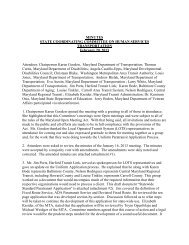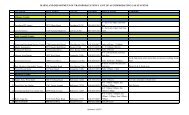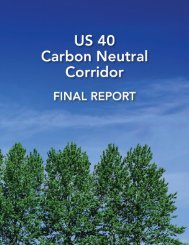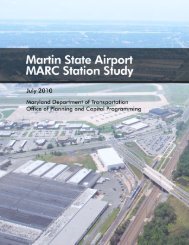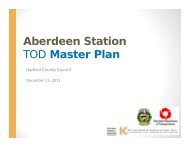PB PlaceMaking - Maryland Department of Transportation
PB PlaceMaking - Maryland Department of Transportation
PB PlaceMaking - Maryland Department of Transportation
You also want an ePaper? Increase the reach of your titles
YUMPU automatically turns print PDFs into web optimized ePapers that Google loves.
Transit-Oriented Development<br />
(TOD) is compatible moderate<br />
to higher density development,<br />
located within an easy walk <strong>of</strong> a<br />
major transit stop, generally with a<br />
mix <strong>of</strong> residential, employment and<br />
shopping opportunities. It is designed<br />
for pedestrians without excluding<br />
the automobile. TOD can be new<br />
construction or redevelopment <strong>of</strong> one<br />
or more buildings, whose design and<br />
orientation facilitate transit use.<br />
Background<br />
TOD mixes uses and emphasizes the pedestrian experience<br />
Increasingly, Transit-Oriented Development (TOD) has grown<br />
to become one <strong>of</strong> the principal driving strategies for economic<br />
revitalization, job creation, and quality mixed-use development in<br />
the greater Baltimore / Washington Metropolitan Region. Although<br />
Baltimore has historically been under-recognized as a target for<br />
this type <strong>of</strong> development activity, this attitude is changing as recent<br />
events suggest there is substantial interest, opportunity and unrealized<br />
capacity for TOD at strategically located sites.<br />
In response to this, the <strong>Maryland</strong> <strong>Department</strong> <strong>of</strong> <strong>Transportation</strong><br />
(MDOT) and the <strong>Maryland</strong> <strong>Department</strong> <strong>of</strong> Planning (MDP) have been<br />
working with the Baltimore City Planning <strong>Department</strong> to identify<br />
TOD opportunities in the City. At the same time, the <strong>Maryland</strong><br />
<strong>Department</strong> <strong>of</strong> General Services (DGS) concluded that surplus<br />
land at the State Center Complex should be made available for<br />
redevelopment and asked MDOT for assistance because <strong>of</strong> its TOD<br />
experience in the Washington region. State agencies recognized the<br />
potential <strong>of</strong> redeveloping the State Center Complex site as a TOD for<br />
two primary reasons:<br />
1. Strengthening the quality <strong>of</strong> the overall community would<br />
increase the value <strong>of</strong> the State’s assets; and<br />
2. Creating a more community-friendly design throughout would<br />
increase the desirability <strong>of</strong> transit use in the area.<br />
Both the State <strong>of</strong> <strong>Maryland</strong> andCity <strong>of</strong> Baltimore seized the<br />
opportunity to understand how the redevelopment <strong>of</strong> State Center<br />
might strengthen the community, increase transit access and use, and<br />
increase the land value <strong>of</strong> their assets by sponsoring the State Center<br />
Transit-Oriented Development Strategy.<br />
State Center Transit Oriented Development Strategy 3



